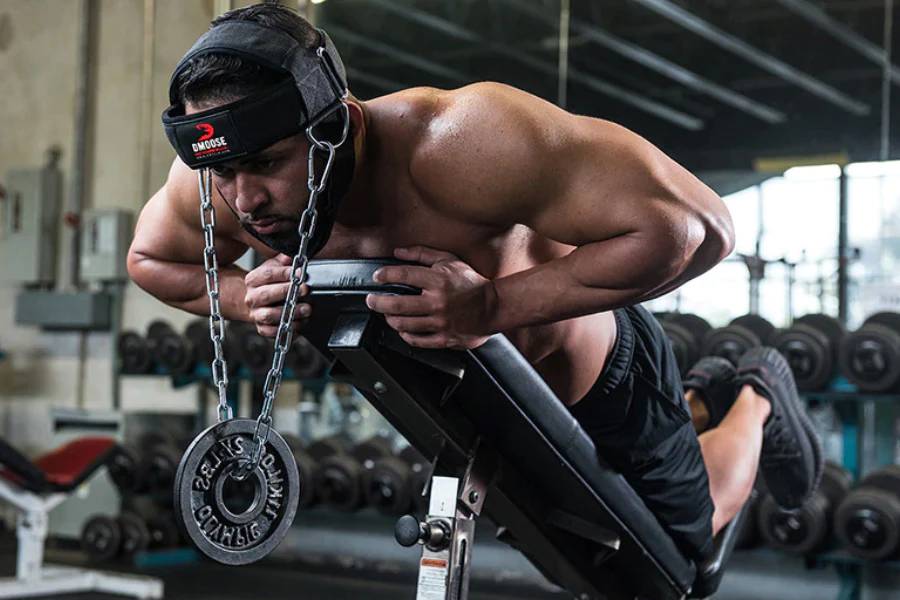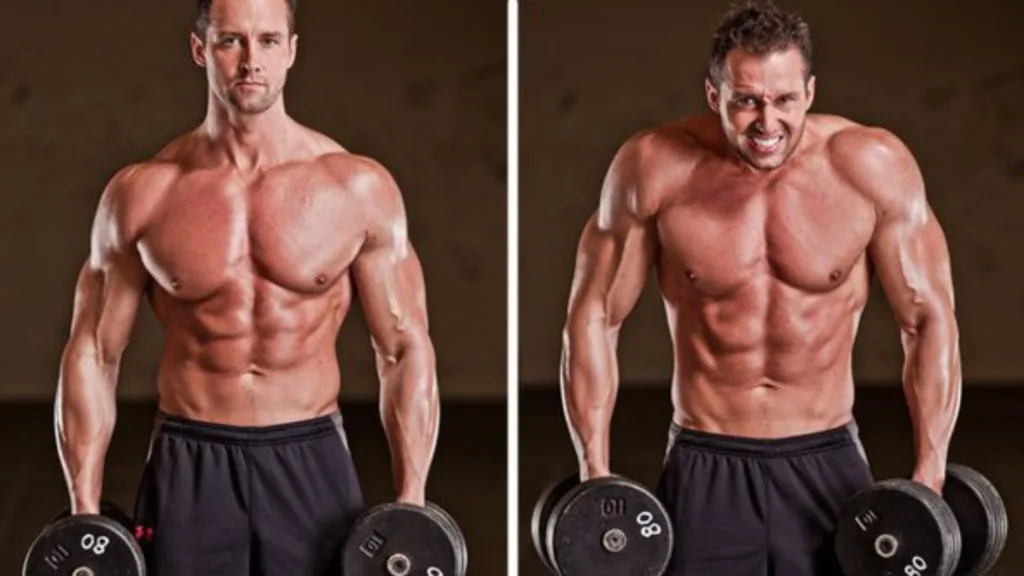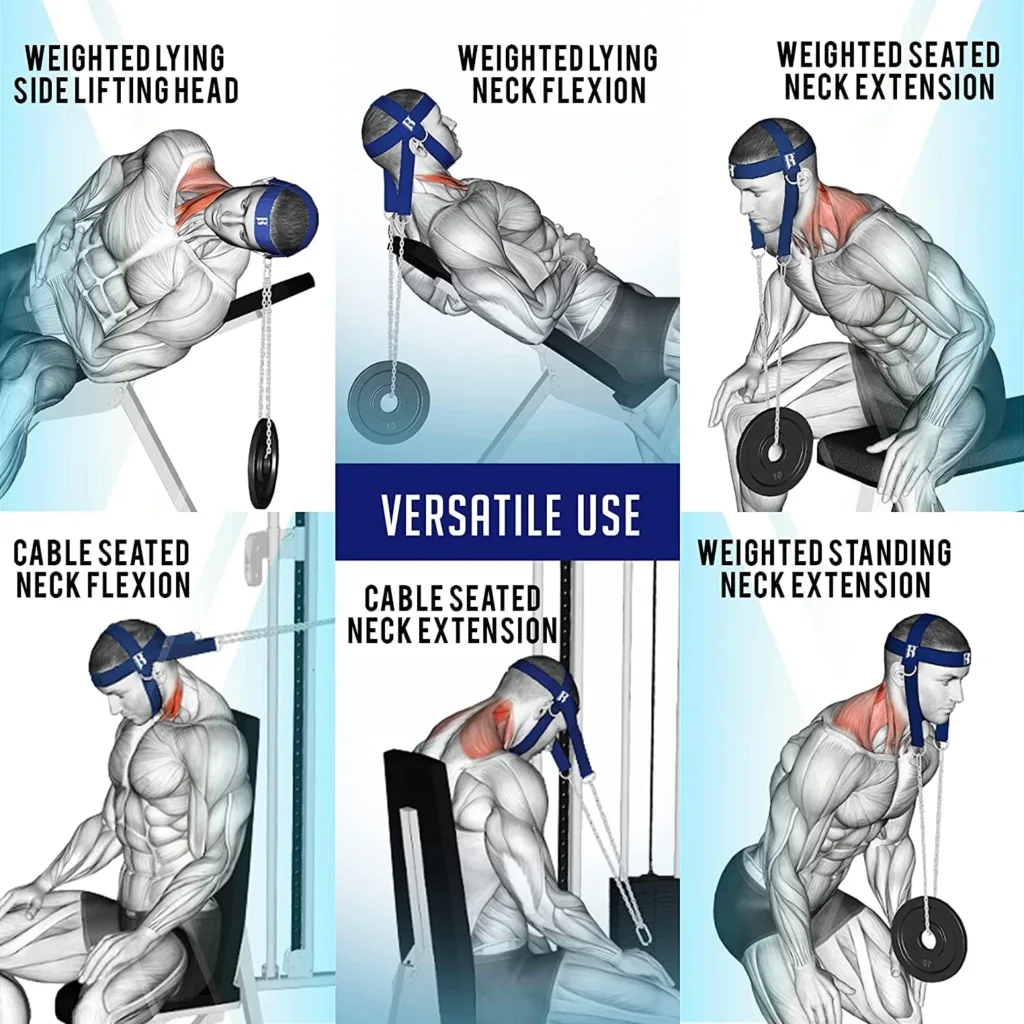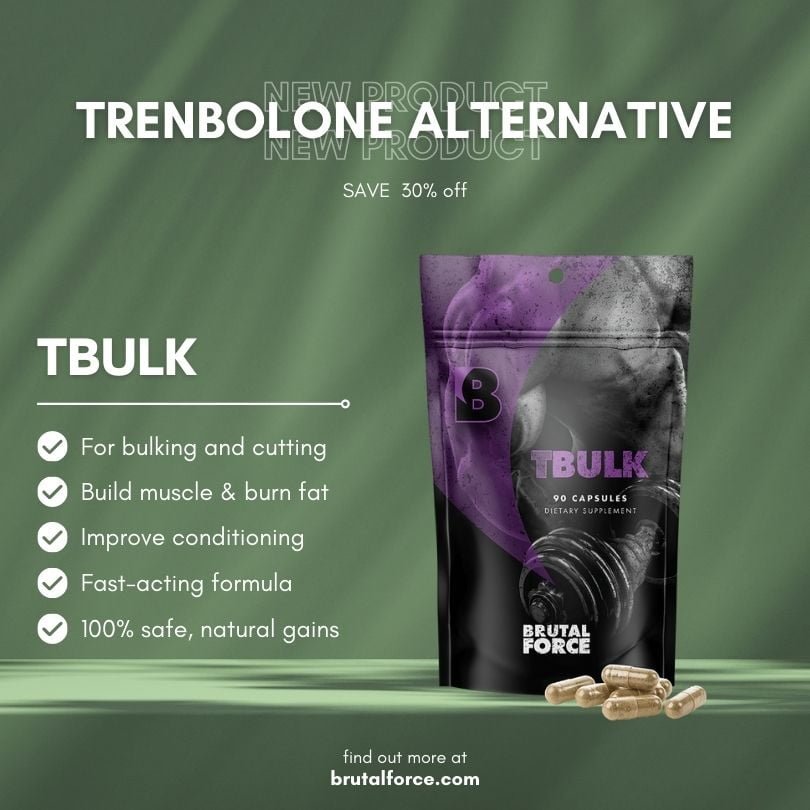Neck Exercises for Mass
Neck exercises for mass and strength requires a specialized approach due to the unique anatomy of the neck muscles.
Engaging in targeted exercises can develop these muscles much like any other group, providing not just aesthetic benefits, but functional ones as well.
Training the neck can be particularly important for those involved in contact sports or activities that demand a strong and resilient neck to prevent injuries.

Choosing the right exercises for neck training is essential. They not only have to stimulate muscle growth effectively, but also need to be performed with proper form to avoid any strain or injury to this delicate area.
Beginning with fundamental exercises to build a foundation and gradually incorporating advanced techniques will ensure the gradual buildup of neck strength and mass.
Key Takeaways
- Targeted neck exercises contribute to both aesthetic and functional benefits.
- Proper form and gradual progression are pivotal in neck muscle development.
- Starting with basics and advancing to complex techniques maximizes growth and safety.
Anatomy of the Neck
When discussing building mass and strength in the neck, understanding the underlying anatomy is crucial. The neck harbors muscles pivotal for posture, head movement, and even respiration.
Major Neck Muscles
Several muscles comprise the neck’s intricate structure, but the most prominent include the sternocleidomastoid, which runs along each side of the neck, visible when turning the head.
Another key group is the scalene muscles, which are found on the sides of the neck and are important for flexing and rotating the neck.
The trapezius muscle spans the neck, shoulders, and back, known for its role in shrugging the shoulders and stabilizing the neck. Lastly, the levator scapulae assist in elevation of the scapula, playing a role in neck tilting and neck posture.
Importance of a Strong Neck
A robust neck supports not just the skull but also facilitates proper spine alignment.
Strong neck muscles can help prevent injuries during physical activity and can be an asset for athletes across various sports.
Neck Anatomy and Functionality
Understanding neck functionality involves more than recognizing the muscle names; it intertwines with how these muscles aid in breathing, posture, and movement.
The sternocleidomastoid, for instance, assists with deep breathing during strenuous activities, while the levator scapulae and scalenes work together to support and move the neck and upper spine.
The trapezius helps stabilize the spine and is essential for a range of movements, from lifting to head turning.
Getting Started with Neck Training

When initiating a regiment of direct neck training, it’s crucial to understand the benefits, assess one’s fitness level for safety, and clearly define the training goals to ensure effective results.
This groundwork lays the foundation for building a strong neck safely and efficiently.
Benefits of Direct Neck Training
Direct neck training goes beyond basic aesthetics, as a strong neck can play a critical role in injury prevention and overall stability.
Athletes benefit significantly from neck strength, as it enhances their ability to absorb impacts and maintain proper form during their performances.
Assessing Fitness Level and Safety
Before one begins neck training, they should evaluate their fitness level to choose the appropriate exercises, weights, and rep ranges.
Someone new to strength training might start with isometric exercises or low-resistance bands to reduce injury risk, while a more experienced individual could incorporate weights or machines designed for neck training.
Defining Your Goals
Setting specific goals for neck training helps in creating a targeted workout plan.
Aspiring for a thick-necked appearance or aiming for functional strength to support athletic activities requires different approaches in training volume and intensity.
One’s goals should inform the exercise selection, frequency of training, and the metrics for tracking progression.
Fundamental Neck Strengthening Exercises
Neck training for mass involves a strategic approach to increase strength and hypertrophy in the neck muscles.
Through targeted movements like neck flexion, neck extension, and lateral flexion, one can develop a strong, muscular neck.
Neck Flexion and Extension
Neck flexion entails bending the neck forward, bringing the chin towards the chest. It primarily works the sternocleidomastoid and the anterior scalene muscles.
For neck extension, the opposite movement is required—tilting the head backward, which engages the upper trapezius and splenius muscles.
These movements can be performed with or without added resistance, such as a weight plate or resistance bands.
- Exercise: To perform a neck extension, one may place a weight plate on the back of the head using a towel for cushioning. They should hyperextend the neck up in a controlled, pain-free motion, focusing on feeling the stretch and contraction.
- Safety Tip: It is crucial to keep the movements slow and controlled to avoid strain and to start with a lower weight to build up strength safely.
Shrugs and Lateral Flexion

Shrugs are an effective exercise for targeting the trapezius muscles, which span the neck, shoulders, and upper back.
Using dumbbells or a barbell, one can perform shrugs by elevating the shoulders as high as possible, holding the contraction momentarily, then slowly lowering them down to the starting position.
Lateral flexion involves the bending of the neck to the side, moving the ear towards the shoulder.
This exercise strengthens the side muscles of the neck, known as the sternocleidomastoid and the scalenes.
Resistance can be added by pressing the hand against the side of the head, as suggested by SET FOR SET.
- Exercise: For lateral flexion, to symmetrically build neck strength, it is important to work both sides of the neck equally by performing the same number of repetitions on each side.
- Safety Tip: Proper form and moderation are key to preventing injury. Overloading the neck with excessive weight can lead to strain, so a focus should be placed on technique rather than heavy lifting.
Advanced Techniques for Building Neck Mass

To effectively enhance neck musculature, advanced trainees often gravitate toward exercises that apply the principles of progressive overload and muscle hypertrophy. Below, two robust techniques are described that are central to adding mass to the neck, which involve weighted neck extensions and the utilization of isometric holds with resistance bands.
Weighted Neck Extension
Weighted neck extensions are a pivotal exercise for targeting the muscles at the back of the neck.
Individuals should start with lighter weights and incrementally increase the load to adhere to the principle of progressive overload, which is critical for muscle hypertrophy.
Begin by lying face down on a bench, with a weight plate positioned at the back of the head.
- Begin with a weight you can manage for 8-12 reps
- Gradually increase the weight as your neck muscles grow stronger
Isometric Holds and Resistance Bands
Isometric holds, combined with resistance bands, provide constant tension that can effectively stimulate neck muscle growth.
They are excellent for enhancing strength and endurance without requiring movement through a traditional range of motion.
- Start with the band anchored at head level and face away
- Keep neck muscles engaged by holding the isometric position for 20-30 seconds per set
Structuring Your Neck Workout

When designing a neck workout, it is crucial to include both warm-up and cool-down phases to prepare the neck muscles for exercise and to facilitate recovery.
A tailored mix of exercises and a sensible approach to training volume are instrumental to achieving growth safely.
Warm-Up and Cool-Down
Warm-Up:
- Always begin with a 5-10 minute general warm-up to increase overall body temperature.
- Specific neck warm-ups could include gentle neck tilts and rotations to foster mobility and prepare the muscles for more intensive work.
Cool-Down:
- Conclude with 5-10 minutes of lower intensity exercises or stretching, aiming for relaxation and reduced muscle tension.
- Incorporate static stretches for the neck, holding each for about 15-20 seconds to aid in recovery.
Exercise Selection and Training Volume
Exercise Selection:
- Utilize a combination of basic and advanced neck exercises to target all areas of the neck.
- Exercises like the upright row and neck bridges are excellent for building mass.
- Prioritize form and technique over weight to prevent injury.
Training Volume:
- Begin with 2 to 3 exercises, conducting 2-3 sets of each.
- Limit repetitions to 8-15 to focus on hypertrophy, while allowing for a rest period of 1-2 minutes between sets.
Common Challenges and Solutions
Building neck mass can lead to common issues such as neck pain and training plateaus. Addressing these challenges involves implementing targeted strategies to reduce pain and progress effectively.
Dealing with Neck Pain and Tension
One often encounters neck pain and neck tension during neck exercises, mainly due to improper form or overexertion.
To reduce pain, it’s crucial to ensure correct head positioning and to use appropriate weights.
For those experiencing chronic neck pain, it’s recommended they integrate mobility work and consider consulting a healthcare professional before continuing with their training routine.
- Tips for Reducing Neck Pain:
- Practice neck stretches and mobility exercises daily.
- Avoid overloading and increase weight gradually.
Overcoming Plateaus in Neck Training
Hitting a plateau in neck training can be frustrating.
One should assess their current routine and make sure they’re varying their exercises and increasing intensity progressively.
Implementing neck exercises for mass, such as dumbbell shrugs and neck bridges, can stimulate growth and help push past these training standstills.
- Strategies to Overcome Training Plateaus:
- Incorporate a mix of isometric holds and dynamic exercises.
- Gradually increase the volume or intensity of workouts.
Assessing and Supporting Recovery
In optimizing muscle growth for the neck, one must not underestimate the necessity of adequate rest and precisely tracking recovery.
These factors are crucial in ensuring effective rehabilitation and progressive overload, which ultimately leads to strength gains while aiming to reduce pain experienced during recovery.
Importance of Rest and Recovery
Rest plays a pivotal role in the process of recovery.
After performing neck exercises, muscles require time to repair and adapt to the stresses placed on them.
It’s important to allow these muscles sufficient time off before re-engaging in intensive training, as this is when actual growth occurs.
A general guideline is to ensure one has at least 24-48 hours of rest before reworking the same muscle group.
Recovery should not be passive; incorporating strategies to actively aid muscle recovery can greatly enhance the repair process.
Techniques such as gentle stretching, proper hydration, and nutrition substantively contribute to one’s recovery itinerary.
Monitoring Progress
To achieve progressive overload, a critical aspect of muscle growth, one must carefully monitor their progress.
This involves keeping a detailed record of workouts, including exercises performed, weights lifted, the number of repetitions and sets, along with noting any pain or discomfort experienced during and after sessions.
A simple table format can be used for monitoring:
| Date | Exercise | Weight | Sets | Reps | Pain (1-10) |
|---|---|---|---|---|---|
| YYYY-MM-DD | Example Neck Exercise | X lbs | Y | Z | N |
Awareness of gradual increases in strength allows for adjustments in exercise intensity, ensuring consistent advancement without over-taxing the muscles, which could lead to injury or chronic pain.
Regular assessment of one’s pain levels guides the customization of exercise regimen to minimize discomfort and support long-term, sustainable growth and strength.
Beyond Exercise: Lifestyle Considerations
While targeted neck exercises are crucial for increasing muscle mass, they must be complemented with proper nutrition and a focus on posture to optimize body composition and ensure the development of a strong, well-defined neck.

Nutrition and Body Composition
Nutrition plays a pivotal role in muscle development and overall body composition.
To promote muscle growth in the neck and elsewhere, one should consume a diet that is rich in protein and includes an appropriate balance of carbohydrates and fats.
Specific nutrient-dense foods can help in muscle recovery and growth, such as lean meats, fish, tofu, beans, and legumes.
- Protein Sources: Chicken, turkey, eggs, and whey protein
- Carbohydrates: Oats, brown rice, and sweet potatoes
- Fats: Avocado, nuts, and olive oil
Ideal dietary habits do not only support muscle growth but also help in managing body fat percentage. A lower body fat percentage can make neck muscles more prominent and defined.
Posture and Daily Habits
Maintaining a better posture is essential for anyone looking to improve their physique, particularly the visibility and strength of neck muscles.
- Sit straight with shoulders pulled back
- Keep the computer monitor at eye level
- Take frequent breaks to stretch
Additionally, integrating neck mobility exercises and stretches into daily habits can further enhance posture.
Regular practice can help prevent stiffness and encourage a natural alignment of the spine and neck.
A consistent focus on posture throughout the day will complement exercise regimens and contribute to a more impressive neck musculature.
Long-Term Strategy for Neck Development
Developing a stronger, thicker neck requires a consistent long-term strategy that is skillfully integrated into one’s overall fitness routine.
This approach should consider the individual’s fitness level and be adaptable to meet specific objectives.
Incorporating Neck Training into Overall Fitness
To achieve a well-developed neck, athletes and fitness enthusiasts should incorporate neck training exercises into their routine at least 2-3 times per week.
This ensures that neck development keeps pace with improvements in overall strength and conditioning. Key exercises include:
- Barbell Shrugs: To target the upper traps.
- Neck Flexion and Extension: Using resistance to strengthen anterior and posterior neck muscles.
- Lateral Flexion: To develop the sides of the neck.
- Neck Bridges: An advanced exercise that targets multiple neck muscles simultaneously.
A balanced program should include a variety of exercises that target all aspects of the neck.
It’s crucial to begin with lighter weights and higher repetitions to build a foundation before progressing to heavier loads.
Adjustments for Specific Objectives
For those seeking a thicker neck, adjustments to the workout routine may be necessary.
A routine might include higher volume training with moderate resistance, focusing on exercises that foster muscle hypertrophy. Examples include:
- High repetitions of Dumbbell Shrugs and Cable Shrugs for muscle endurance.
- The inclusion of neck curl variations to build the front of the neck.
For improving muscular endurance, incorporating longer sets with a smaller load is beneficial.
Alternating periods of higher weight with lower repetitions and lower weight with higher repetitions can be effective for those working on both size and endurance.
These strategies should always align with the individual’s overall fitness goals and current fitness level to ensure safety and optimal results.
Frequently Asked Questions
This section addresses common inquiries about building neck muscle mass, detailing exercise choices, safety at home, gym equipment, targeted techniques, and training routines.
What are the most effective exercises for increasing neck muscle mass?
Exercises such as neck bridges and neck extensions are widely recognized for their efficacy in building neck muscle mass when performed consistently and with proper form.
How can I safely perform neck exercises at home to build mass?
Ensuring safe practice at home involves utilizing proper techniques, such as isometric exercises, which can be executed without equipment, and maintaining the pain-free range of motion described in research from Verywell Fit.
Which gym equipment is specifically beneficial for neck muscle development?
Equipment such as harnesses for neck extensions, weighted plates for resistance, and machines for shrugs offer structured support and can enhance neck muscle development effectively.
Are there specialized techniques for females seeking to achieve a thicker neck?
There are no gender-specific exercises for neck muscle development; female trainees can follow the same principles of muscle growth, focusing on progressive overload and adaptation.
What is the recommended frequency and intensity for neck training to optimize growth?
Training the neck muscles 2-4 times per week with moderate to high repetitions, as suggested by experts, ensures muscle growth while allowing adequate recovery, with specific recommendations of 9 sets per week at a minimum.
Can you suggest a neck training routine that incorporates dumbbells for muscle gain?
A routine involving upright rows and shrugs with dumbbells can be effective for neck muscle gain. These exercises target various neck and upper back muscles to encourage hypertrophy.


